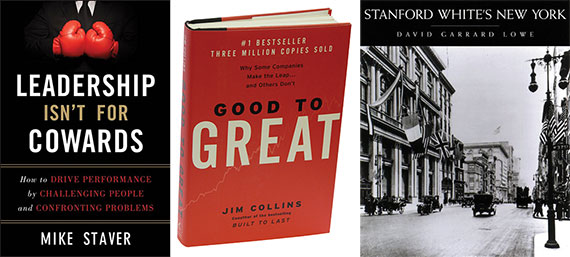Trending
What they’re reading now
Real estate pros share their pick of books about tough leadership and NYC architects with a scandalous past

Where do you look for insight and inspiration? To find out, The Real Deal asks leaders in the industry what they’re reading.
Diane Ramirez
CEO, Halstead Property
What are you reading right now or what did you finish most recently?
Over the summer, I read “Leadership Isn’t for Cowards,” by Mike Staver.
What spurred you to read that book?
The book is very relevant for day-to-day management, which is absolutely crucial for anyone in business.
Has anything you read in it stuck with you? Would you recommend it to others?
The book was informative and full of sound, practical advice. It was engaging and interesting, and throughout reading it, I would make notes as to what would help me or one of my directors handle specific situations at work.
Gary Malin
President, Citi Habitats
What are you reading right now, or what did you finish most recently?
I just finished reading “Good to Great,” by Jim Collins. It’s a management classic. The book explains what differentiates great companies from the rest of the pack, and outlines how average companies can morph into great ones. I first read it many years ago, back when I was on a “business books” kick, but I just picked it up again.
What spurred you to read that book?
I always tell our agents that this is the time of year to take stock of their careers, take note of their successes and failures, and make a concrete plan for the coming year. So I decided to do the same, and this book helps bring me back to the fundamental principles that guide our business. Our company continues to go through changes to elevate it to the next level. For us, standing still is never an option and we are never complacent in our approach.
Has anything you read in it stuck with you? Would you recommend it to others?
One of the key ideas in the book is that it’s important to focus on the “who,” then the “what.” You have the get all the right people on the bus before you decide where you want to go. In addition, your employees have to understand — and believe in — your company’s mission. If everyone on board believes in the same concept, you will get to your goal a lot faster. I think Citi Habitats’ greatest asset is its people, and this book reinforced the notion to me that with the right people, anything is possible.
I would definitely recommend this book, as it has made a big impact on my management style. It’s helpful to leaders of companies that are in growth mode — or anyone who strives for greatness.
Tom Postilio
Founding member, Core
What are you reading right now?
I’m currently enjoying “Stanford White’s New York,” by David Garrard Lowe. Unlike many of the books written about this Gilded Age luminary, Lowe’s account of White places more emphasis on the man and his immeasurable talent than on the scandalous details of his sensational murder on the rooftop of his iconic Madison Square Garden.
What spurred you to read that book?
My partner, Mickey Conlon, is a Stanford White scholar, and while I have always had a great admiration for White’s work here in the city, I thought it was time to dig a little deeper. Through an unusual series of coincidences, we have a long list of personal and professional connections to White and his work that stretches all the way from The Players on Gramercy Park, of which we’re members, out to the hamlet of Saint James on Long Island, where White’s country estate, Box Hill, still remains in the family. Mickey grew up in Saint James, and we’re now building a house down the street from Box Hill. It’s inevitable that Stanny’s hand will be evident in the design.
Has anything you read in it stuck with you?
White’s ability to dazzle the eye and sprit through design amazes me, as does the recklessness that allowed too many of his masterpieces to be destroyed in pursuit of mediocrity.




